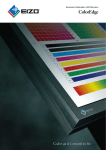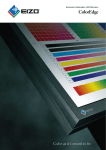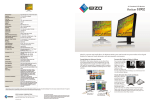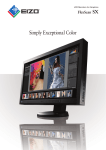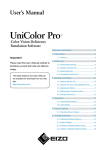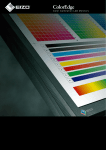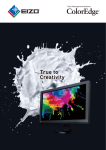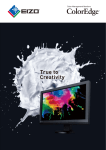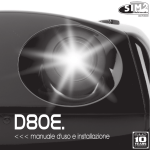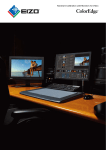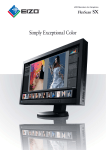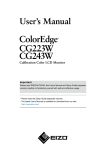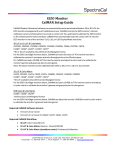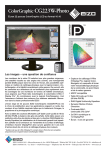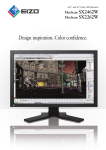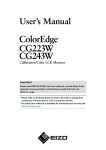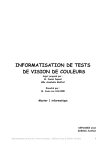Download "user manual"
Transcript
Hardware Calibration LCD Monitors ColorEdge Series Color as it’s meant to be 1 ColorEdge — perfect color results for your digital workflow Choosing the right monitors for a color management system The Importance of Color Management In today’s digital production environment, there are many opportunities for discrepancies in color to arise along the path from the computer to the printer. This is because input devices (cameras, scanners, etc.), display devices (monitors) and output devices (various kinds of printers) may all be set to different color spaces. Such discrepancies can be avoided by employing a color management system that ensures every device in the production chain is set to a common color space. them ideal for a wide range of professional environments where color reproduction is critical, including photography, graphics, printing and publishing. Color Management Begins with the Monitor The monitor is the core of any professional color management system. If color is displayed accurately on the monitor, and color matching has been done with the output device, then you no longer have to make multiple proofs just to correct for color discrepancies. You can proof with confidence right from the start, while lowering costs, increasing effi ciency and improving quality control. ColorEdge — the Right Monitors for Color Management Effective color management requires monitors with accurate color reproduction and gradation characteristics. With ColorEdge monitors you get factory-adjusted gamma, extensive hardware calibration capabilities and an exceptionally wide color gamut. Their outstanding performance and reliability make 2 Device-Specific Color Information CMYK Printer Device-Specific Color Information Device-Specific Color Information Inkjet Printer Monitor Common Color Space Digital Camera Scanner Printer Device-Specific Color Information Device-Specific Color Information Device-Specific Color Information Adobe RGB color space reproduction — connecting the photographer, designer, and printer center of a system using Adobe RGB as the common color space is the ideal way to ensure accurate color reproduction across all digital platforms. Such a color management environment fully supports soft proofi ng at every step of production, from initial photography to fi nal printing. Soft Proofing with Adobe RGB Wide Color Gamut Monitors The benefits of color management quickly become apparent once a system is put into place. When all devices share a common color space, colors match at every stage of production; knowing that color is being accurately displayed naturally improves effi ciency. A wide-gamut ColorEdge monitor at the Photography Design Prepress/Printing Adobe RGB color space throughout entire workflow Shoot Check Data Process Image Masking Compositing Adjustment No need for Photoshop color engine Layout Layout Enlarging Reducing Clipping Paths Edit Adobe RGB image Soft proof Edit Print 0.9 With a wide color gamut that Color Reproduction Area (xy Coordinate) reproduces nearly 100% of 0.8 Adobe RGB the Adobe RGB color space, 0.7 sRGB ISO Coated these models not only cover the 0.6 Color Space sRGB color space 0.5 y supported by many 0.4 computer monitors, 0.3 operating systems 0.2 and digital cameras, 0.1 but practically the 0.0 0.6 0.7 0.1 0.2 0.8 0.3 0.4 0.5 entire ISO-coated x and US web-coated CMYK color spaces used in printing as well. Edit while simulating CMYK color space 3 Consummate Performance and Functionality Factory Adjustment of Gamma 16-Bit LUT, 10-Bit Simultaneous Display The gamma level for each ColorEdge monitor is adjusted at the factory. This is accomplished by measuring the R, G, and B gamma values from 0 – 255, then using the monitor’s 16-bit look-up table (LUT) to select the 256 most appropriate tones to achieve the desired value. Most ColorEdge monitors offer 10-bit simultaneous color display* from a 16-bit look-up table which means they can show more than one billion colors simultaneously. This is 64 times as many colors as you get with 8-bit display which results in even smoother color gradations and reduced Delta-E between two adjacent colors. *A graphics board and soft ware which support 10-bit output are also necessary for 10-bit display. 8-bit and 10-bit image display Each monitor adjusted individually at the factory. (For illustrative purposes only. Actual adjustment is performed in a darkroom.) Gamma Correction Input Typical Monitor Internal processing 8 bit Output 8 bit 8-bit display ON-SCREEN IMAGE Color Seepage Tonality Breakup Smooth Grayscale Display ColorEdge 8 bit 8-bit display Ideal Gamma Curve Brightness GAMMA CURVE Brightness This is important because accurate, nonfluctuating gamma values are necessary for the proper display of color. If colors are not based on specifi c values and cannot be adjusted, images will be displayed differently by different monitors. ColorEdge monitors provide both precision and consistency, so graphics professionals can be sure that the fi nal product will look exactly the way they want it to. In fact, each monitor comes with an adjustment certifi cate that certifi es the measurement results of the gamma value. ColorEdge 10 bit 16-bit LUT 8 bit 16-bit LUT 10 bit 10-bit display Ideal Gamma Curve Uncorrected Gamma Curve 3D LUT for Better Additive Color Mixture 256 Tones 256 Tones All ColorEdge models R incorporate a look-up table (LUT) for accurate color and grayscale rendering, but the ColorEdge CG275W, CG245W, CG243W, and CG223W utilize an EIZOB developed 3D LUT. Whereas a typical 1D LUT adjusts G color on separate tables for 3D LUT image each red, green, and blue, a 3D LUT accomplishes this on a single, mixed-color cubic table. A 3D LUT improves the monitor's additive color mixture (combination of RGB), a key factor in its ability to display neutral gray tones. Brightness and Color Uniformity with DUE Predictable Color with Any Media Fluctuations in brightness and chroma on different parts of the screen are a common trait of LCD monitors. To counteract this, EIZO incorporates a Digital Uniformity Equalizer (DUE) in all ColorEdge monitors. DUE utilizes the monitor’s 16-bit look-up table (LUT) with an extensive palette of 65,281 grayscale tones for each R, G, and B to ensure a Delta-E difference of 3 or less across the screen when the monitor leaves the factory.* With content published on so many different types of printed and digital media it's critical to know how your clients will see color. A ColorEdge monitor and the bundled ColorNavigator software let you do just that as they are designed for both softproofi ng and digital device emulation. So now you can "predict" how color will appear to your clients whether you produce content for printed media like books and magazines or for digital media devices like tablets, smart phones, and notebook computers. *Delta-E difference for the CG303W is 5 or less along the screen perimeter. With Digital Uniformity Compensation Without Digital Uniformity Compensation Color-separated image with Delta-E*ab distribution across the screen of the ColorEdge CG221 (gray level 128 measured) 4 Extensive Calibration Capabilities Simple and Precise Calibration Light Box Brightness Adjustment The EIZOdeveloped ColorNavigator software makes calibration both simple and accurate. Instead of having to judge colors and do time-consuming inputting, or having a specialist do it for you, all you need to do is input target values for brightness, white point and gamma. ColorNavigator works with a wide range of measurement devices to directly utilize the 16-bit LUT of ColorEdge monitors for accurate and reliable calibration in minutes. The latest version of ColorNavigator is always available as a free download at www.eizo.com. With ColorNavigator and a measurement device, you can set your light box’s* brightness to the desired value. ColorNavigator can then take the resulting brightness level and set it as the monitor’s target calibration value to ensure uniform brightness between your monitor and light box when color proofi ng. Industry’s First Self-Calibrating Monitors The ColorEdge CG245W and CG275W come with an industry-fi rst built-in calibration sensor. The sensor is housed within the monitor’s bezel and swings out only when calibrating. This eliminates the need ColorEdge CG245W built-in sensor for an external sensor, lets you calibrate when your computer is off, and saves time by letting you schedule the monitor to self-calibrate while you are not working. To ensure predictable and accurate calibration across the screen, EIZO calibrates the center of the screen at its factory and correlates the built-in sensor to these results. Furthermore, if you are working with other ColorEdge monitors and need to standardize calibration, you can use the bundled ColorNavigator software to correlate the calibration results of the built-in sensor to the results obtained from an external calibration device. Paper White Measurement ColorNavigator offers a paper white measurement function for color matching between the image on your monitor and the image on your printouts. By measuring the white of the paper to be used for printing, ColorNavigator will automatically set the target values for brightness and white point accordingly. *Currently supports JUST Color Communicator 1 and 2 only. Profile Validation This function measures the monitor’s color patches to determine the difference between the Delta-E value of the monitor’s profi le and the actual displayed values of the monitor. This allows for verifying the results of calibration or checking to see how much the monitor’s colors have varied since it was last calibrated. ColorNavigator can also measure CMYK color patches (GRACoL 2006 Coated #1 and FOGRA39) and output them as Adobe Photoshop or Acrobat fi les.* The measurement results of both the monitor and profi le for each color patch are indicated in either CIELAB or XYZ values, and the difference between them expressed in Delta-E. The Delta-E variation can be shown in a graph and compared with previous results. ColorNavigator even exports profi le validation results as a PDF for easy distribution among work sites, printers, or clients. *Photoshop CS1 or later or Acrobat Professional 7 or later are required for Macintosh, and Photoshop CS1 or later or Acrobat Professional 8 or later are required for Windows. Post-Calibration Color Adjustment Sometimes due to variations in output from different printers or the special requirements of a project, it is necessary to fi ne-tune an otherwise perfectly calibrated monitor to match target colors. ColorNavigator lets you easily adjust hue and saturation for all six primary and secondary colors (RGB and CMY), as well as white balance, brightness, black level and gamma, to achieve the closest possible visual match. For confi rmation of calibration results or to achieve more accurate manual adjustments, a test pattern screen with a grayscale ramp, low tones, high tones and gamma values can be displayed. ColorNavigator Compatible Measurement Devices X-Rite: Eye-One Series, ColorMunki*, DTP94, DTP94B DataColor: Spyder 2, Spyder 3 *ColorMunki Create is not compatible. ColorNavigator Compatible Operating Systems Compatible Operating Systems* Macintosh Windows OS X 10.4 – 10.6 7 (32/64-bit), Vista (32/64-bit), XP (32/64-bit) *A version of ColorNavigator with Mac OS X 10.3.9 compatibility for the CG303W, CG243W, CG241W, CG223W, and CG221 is available on www.eizo.com. 5 Specifications Panel Size 29.8" / 76 cm (756 mm diagonal) 27” / 68 cm (684 mm diagonal) 24.1" / 61 cm (611 mm diagonal) Viewing Angles (H, V) 178°, 178° (at contrast ratio of 10:1) 178°, 178° (at 10:1 contrast ratio) 178°, 178° (at contrast ratio of 10:1) Panel Type IPS IPS (with overdrive circuit) IPS (with overdrive circuit) Brightness 260 cd/m2 (maximum) 120 cd/m2 or less (recommended1) 270 cd/m2 (maximum) 120 cd/m2 or less (recommended1) 270 cd/m2 (maximum) 120 cd/m2 or less (recommended1) Contrast 850:1 850:1 850:1 Response Time (Typical) Black-white-black: 12 ms Gray-to-gray 6 ms, black-white-black 12 ms Gray-to-gray: 5 ms, black-white-black: 13 ms Native Resolution Signal 1: 2560 × 1600; Signal 2: 1920 × 1200 2560 × 1440 1920 × 1200 Pixel Pitch 0.2505 × 0.2505 mm 0.2331 × 0.2331 mm 0.270 × 0.270 mm Display Colors (Maximum) DVI (8 bit): 16.77 million from a palette of 278 trillion DVI (10 bit): 1.07 billion from a palette of 278 trillion 1.07 billion from a palette of 278 trillion DVI: 16.77 million from a palette of 278 trillion DisplayPort: 1.07 billion from a palette of 278 trillion Wide Gamut Coverage Adobe RGB: 98%, sRGB: 100% Adobe RGB 97%, sRGB: 100% Adobe RGB: 98%, sRGB: 100% Look-Up Table Bit Depth 16 bits per color 16 bits per color 16 bits per color 3D Look-Up Table – Yes Yes Screen Uniformity1 Center: E≤3, Perimeter: E≤5 Entire Screen E≤3 Entire Screen: E≤3 Dot Clock 269 MHz 242 MHz Analog: 170 MHz, Digital: 164.5 MHz Analog Scanning Frequency (H, V) – – 24 – 76 kHz, 47.5 – 86 Hz Digital Scanning Frequency (H, V) 26 – 100 kHz, 29.5 – 30.5 Hz/59 – 61 Hz (VGA Text: 69 – 71 Hz) 26 – 89 kHz, 23.75 – 63 Hz (VGA Text 69 – 71 Hz) 26 – 78 kHz, 23.75 – 63 Hz (VGA Text: 69 – 71 Hz) Video Input Terminals DVI-D 24 pin × 2 (dual link × 1, single link × 1 [with HDCP] ) DisplayPort × 1 (with HDCP), Mini DisplayPort × 1 (with HDCP), DVI-D 24 pin × 1 (with HDCP) DVI-I 29 pin × 2 (with HDCP), DisplayPort (with HDCP) USB Ports / Standard 1 upstream, 2 downstream / USB 2.0 1 upstream, 2 downstream / USB 2.0 1 upstream, 2 downstream / USB 2.0 Power Requirements AC 100 – 120 V / 200 – 240 V, 50 / 60 Hz AC 100 – 120 V / 200 – 240 V, 50 / 60 Hz AC 100 – 120 V / 200 – 240 V, 50 / 60 Hz Power Consumption 170 W (maximum), 81 W (typical) 160 W (maximum), 64 W (typical) 100 W (maximum), 48 W (typical) Power Save Mode Less than 1.5 W Less than 1 W Less than 1 W Height Adjustment Range 118 mm 151.5 mm (maximum 190 mm) 157 mm Tilt / Swivel / Pivot 40° Up, 0° Down / 35° Right, 35° Left / 90° 25° Up, 0° Down / 172° Right, 172° Left / 90° 30° Up, 0° Down / 172° Right, 172° Left / 90° Dimensions (W × H × D) With Stand: 689 × 511.5 – 629.5 × 254.7 mm; Without Stand: 689 × 450 × 90 mm With Stand: 646 × 425 – 576.5 × 281.5 mm; Without Stand: 646 × 402 × 92 mm With Stand: 566 × 396.5 – 553.5 × 242 – 256 mm; Without Stand: 566 × 382 × 92.5 mm Net Weight With Stand: 16.1 kg Without Stand: 11.6 kg With Stand: 13.6 kg Without Stand: 9.7 kg With Stand: 10.1 kg Without Stand: 7.1 kg Preset Modes Fine Contrast (Custom, sRGB, Calibration, Emulation) Color Mode (Custom, Adobe RGB, sRGB, Rec709, EBU, SMPTE-C, DCI, Calibration) Color Mode (Custom, Adobe RGB, sRGB, Rec709, EBU, SMPTE-C, DCI, Calibration) Supplied Accessories AC power cord, signal cables (DVI-D – DVI-D, DVI-D – DVI-D [dual link supported]), USB cable, setup guide, EIZO LCD Utility Disk (ColorNavigator software, PDF user’s manual), adjustment certificate, ScreenCleaner, monitor hood, quick reference, warranty card AC power cord, signal cable (DVI-D – DVI-D [dual link supported], Mini DisplayPort – DisplayPort), USB cable, setup guide, EIZO LCD Utility Disk (ColorNavigator software, PDF user’s manual), adjustment certificate, ScreenCleaner, monitor hood, quick reference AC power cord, signal cables (DVI-D – DVI-D, DisplayPort – DisplayPort), USB cable, setup guide, EIZO LCD Utility Disk (ColorNavigator software, PDF user’s manual), adjustment certificate, ScreenCleaner, monitor hood, quick reference, warranty card Warranty Five Years2 Five Years2 Five Years2 1 Measured at gray level 128 and color temperature of 5000 K. 2 The usage time is limited to 30,000 hours and the warranty period of the LCD panel is limited to three years from the date of purchase. The warranty period of the backlight is warranted only if it is used within the recommended brightness of up to and including 100 cd/m 2 for the CG221 and 120 cd/m 2 for the CG303W, CG275W, CG245W, CG243W, CG241W, and CG223W with the color temperature for the aforementioned models between 5,000 K – 6,500 K and limited to three years from the date of purchase subject to the usage time being less than or equal to 10,000 hours. All ColorEdge monitors meet the ISO9241-307 (Pixel fault class I) standard. With current LCD technology, a panel may contain a limited number of missing or flickering pixels. Accessories Monitor Hoods Panel Protectors Screen Cleaner Kit Bundled with all models, EIZO's monitor hoods include a sliding top cover so they can remain in place when the monitor is calibrated. With the CG275W and CG245W, the hood can be used in portrait mode, too. These protection sheets are easy to place over the screen surface, allow a minimum of 87% light transmission, and prevent dust and scratches. (Available for the CG243W, CG241W, and CG223W. Sold separately.) Keep your screen free from dust and fi ngerprints with this bundled screen cleaner kit. Includes pump spray and cloth. 6 24.1" / 61 cm (611 mm diagonal) 24.1" / 61 cm (611 mm diagonal) 22" / 56 cm (558 mm diagonal) 22.2" / 56.4 cm (563 mm diagonal) 178°, 178° (at contrast ratio of 10:1) 178°, 178° (at contrast ratio of 10:1) 178°, 178° (at contrast ratio of 10:1) 170°, 170° (at contrast ratio of 10:1) IPS (with overdrive circuit) VA (with overdrive circuit) VA (with overdrive circuit) IPS 270 cd/m2 (maximum) 120 cd/m2 or less (recommended1) 300 cd/m2 (maximum) 120 cd/m2 or less (recommended1) 270 cd/m2 (maximum) 120 cd/m2 or less (recommended1) 200 cd/m2 (maximum) 100 cd/m2 or less (recommended1) 850:1 850:1 950:1 400:1 Gray-to-gray: 5 ms, black-white-black: 13 ms Gray-to-gray: 6 ms, black-white-black: 16 ms Gray-to-gray: 6 ms, black-white-black: 12 ms Gray-to-gray: –, black-white-black: 30 ms 1920 × 1200 (16:10 aspect ratio) 1920 × 1200 (16:10 aspect ratio) 1680 × 1050 (16:10 aspect ratio) 1920 × 1200 (16:10 aspect ratio) 0.270 × 0.270 mm 0.270 × 0.270 mm 0.282 × 0.282 mm 0.249 × 0.249 mm DVI: 16.77 million from a palette of 278 trillion DisplayPort: 1.07 billion from a palette of 278 trillion 16.77 million from a palette of 278 trillion DVI: 16.77 million from a palette of 278 trillion; DisplayPort: 1.07 billion from a palette of 278 trillion 16.77 million from a palette of 278 trillion Adobe RGB: 98%, sRGB: 100% Adobe RGB: 96%, sRGB: 98% Adobe RGB: 95%, sRGB: 98% Adobe RGB: 98%, sRGB 98% 16 bits per color 16 bits per color 16 bits per color 16 bits per color Yes – Yes – Entire Screen: E≤3 Entire Screen: E≤3 Entire Screen: E≤3 Entire Screen: E≤3 Analog: 170 MHz, Digital: 164.5 MHz Analog: 202.5 MHz, Digital: 164.5 MHz Analog: 150 MHz, Digital: 120 MHz Analog: 202.5 MHz, Digital: 162 MHz 24 – 76 kHz, 47.5 – 86 Hz 24 – 94 kHz, 47.5 – 86 Hz 24 –82 kHz, 47.5 – 86 Hz 31 – 94 kHz, 49 – 86 Hz 26 – 78 kHz, 23.75 – 63 Hz (VGA Text: 69 – 71 Hz) 26 – 78 kHz, 47.5 – 63 Hz (VGA Text: 69 – 71 Hz) 31 – 65 kHz, 47.5 – 61 Hz (VGA Text: 69 – 71 Hz) 31 – 76 kHz, 59 – 61 Hz (VGA Text: 69 – 71 Hz) DVI-I 29 pin × 2 (with HDCP), DisplayPort (with HDCP) DVI-I 29 pin × 2 (with HDCP) DVI-I 29 pin × 2 (with HDCP), DisplayPort (with HDCP) DVI-I 29 × 2 1 upstream, 2 downstream / USB 2.0 1 upstream, 2 downstream / USB 2.0 1 upstream, 2 downstream / USB 2.0 1 upstream, 2 downstream / USB 2.0 AC 100 – 120 V / 200 – 240 V, 50 / 60 Hz AC 100 – 120 V / 200 – 240 V, 50 / 60 Hz AC 100 – 120 V / 200 – 240 V, 50 / 60 Hz AC 100 – 120 V / 200 – 240 V, 50 / 60 Hz 95 W (maximum), 48 W (typical) 110 W (maximum) 85 W (maximum), 39 W (typical) 100 W (maximum) Less than 0.9 W Less than 2 W Less than 0.9 W Less than 2 W 157 mm 82 mm 74 mm 100 mm 40° Up, 0° Down / 35° Right, 35° Left / 90° 40° Up, 0° Down / 35° Right, 35° Left / 90° 30° Up, 0° Down / 172° Right, 172° Left / 90° 30° Up, 3° Down / 35° Right, 35° Left / – With Stand: 566 × 381.5 - 538.5 × 242 -256 Without Stand: 566 × 367 × 85 mm With Stand: 566 × 456 – 538 × 230 mm Without Stand: 566 × 367 × 85 mm With Stand: 511 × 347.5 – 521.5 × 240.5 – 256 mm Without Stand: 511 × 333 × 85 mm With Stand: 565 × 452.5 – 552.5 × 272 mm Without Stand: 565 × 394.5 × 101 mm With Stand: 10.1 kg Without Stand: 7.1 kg With Stand: 11 kg Without Stand: 7.4 kg With Stand: 9.6 kg Without Stand: 6.6 kg With Stand: 14.5 kg Without Stand: 10.4 kg Color Mode (Custom, sRGB, Rec709, EBU, SMPTEC, DCI, Calibration) Fine Contrast (Custom, sRGB, Calibration, Emulation) Color Mode (Custom, sRGB, Rec709, EBU, SMPTEC, DCI, Calibration) Fine Contrast (sRGB, Custom, Calibration, Emulation) AC power cord, signal cables (DVI-D – DVI-D, DisplayPort – DisplayPort), USB cable, setup guide, EIZO LCD Utility Disk (ColorNavigator software, PDF user’s manual), adjustment certificate, ScreenCleaner, monitor hood, quick reference, 4 screws for mount option, warranty card AC power cord, signal cables (DVI-D – DVI-D, DVI-I – D-Sub mini 15 pin), USB cable, setup guide, EIZO LCD Utility Disk (ColorNavigator software, PDF user’s manual), adjustment certificate, ScreenCleaner, monitor hood, quick reference, warranty card AC power cord, signal cables (DVI-D – DVI-D, DisplayPort – DisplayPort), USB cable, setup guide, EIZO LCD Utility Disk (ColorNavigator software, PDF user’s manual), adjustment certificate, ScreenCleaner, monitor hood, quick reference, warranty card AC power cord, signal cables (DVI-D – DVI-D, DVI-I – D-Sub mini 15 pin), USB cable, setup guide, EIZO LCD Utility Disk (ColorNavigator software, HTML user’s manual, ICC Profile), adjustment certificate, ScreenCleaner, monitor hood, quick reference, warranty card Five Years2 Five Years2 Five Years2 Five Years2 Color Universal Design Feature Warranty Color Vision Deficiency Simulation Brightness and Color Warranty To accommodate the more than 200 million people worldwide with a color vision deficiency, care must be taken when choosing color schemes, otherwise important details may not be discernible. These models instantly simulate how still and moving images appear to people with redOriginal mode Protanope mode green (protanopia and deuteranopia) and blue-yellow (tritanopia) color vision deficiency through internal hardware conversion and EIZO proprietary software. (Compatible with Windows 7, Vista, and XP, and with Macintosh OS X 10.3.9 or later. This feature is not available with the CG221.) Deuteranope mode EIZO offers a five-year warranty for all ColorEdge monitors. The backlight is warranted for three years at a brightness of up to a specific figure and color temperature from 5,000 – 6,500 K with the usage time a maximum of 10,000 hours. (See footnote 1 on page 6 for brightness figures.) Tritanope mode 7 153 Shimokashiwano, Hakusan, Ishikawa 924-8566 Japan Phone +81-76-277-6792 Fax: +81-76-277-6793 www.eizo.com © 2012 Eizo Nanao Corporation All product names are trademarks or registered trademarks of their respective companies. ColorEdge and EIZO are registered trademarks of Eizo Nanao Corporation. Adobe product screenshots reprinted with permission from Adobe Systems Incorporated. Specifications are subject to change without notice. Published on chlorine-free paper. (060907m) Printed in Japan, 3, 2012, 4K









